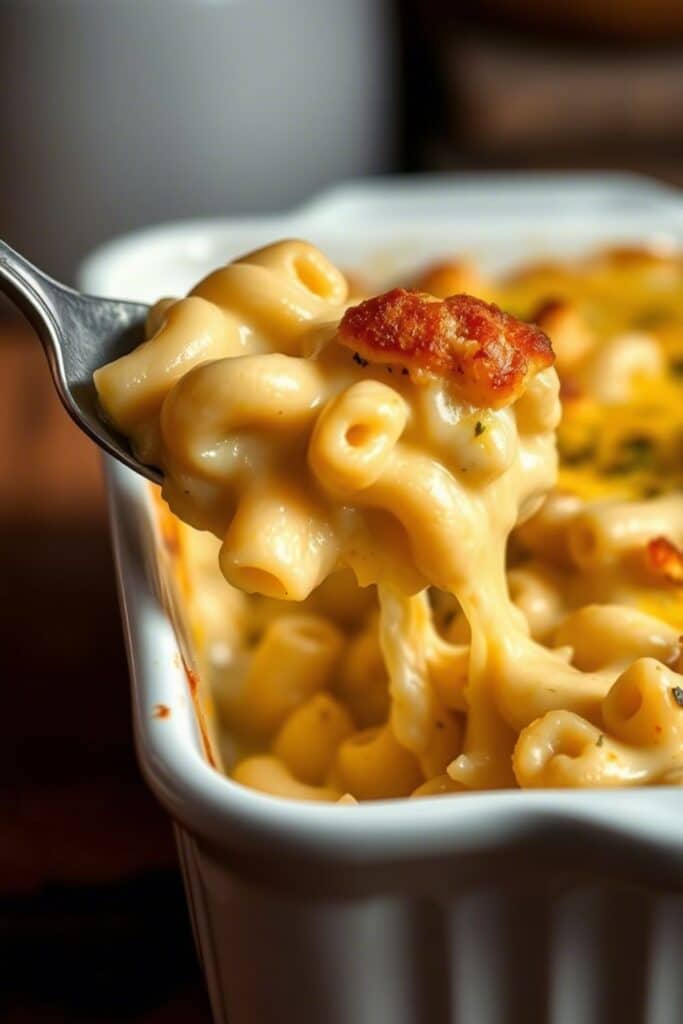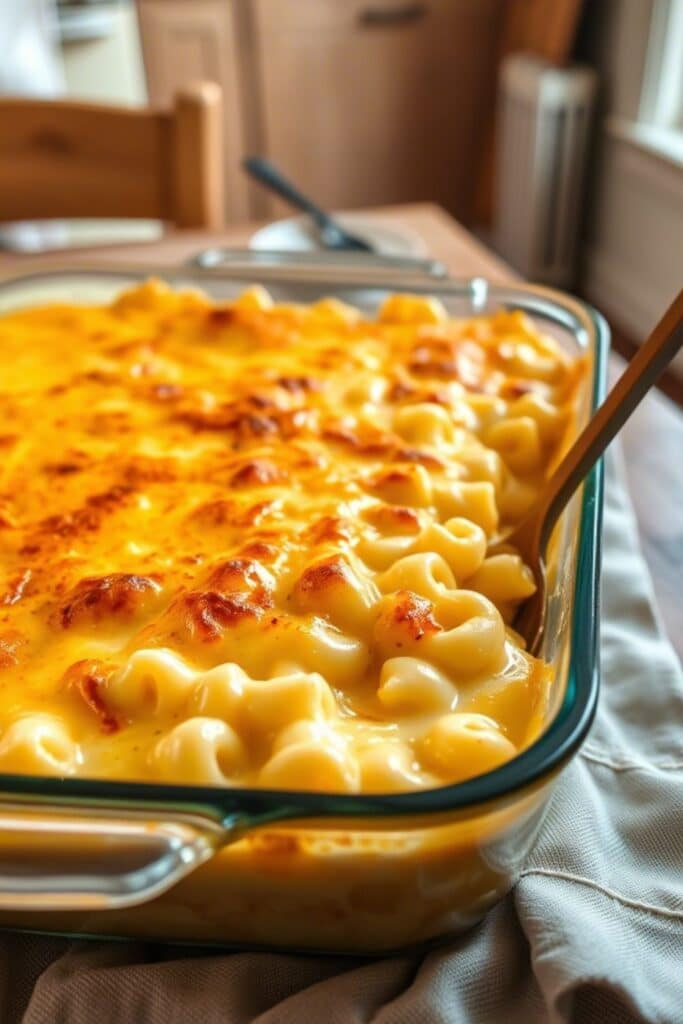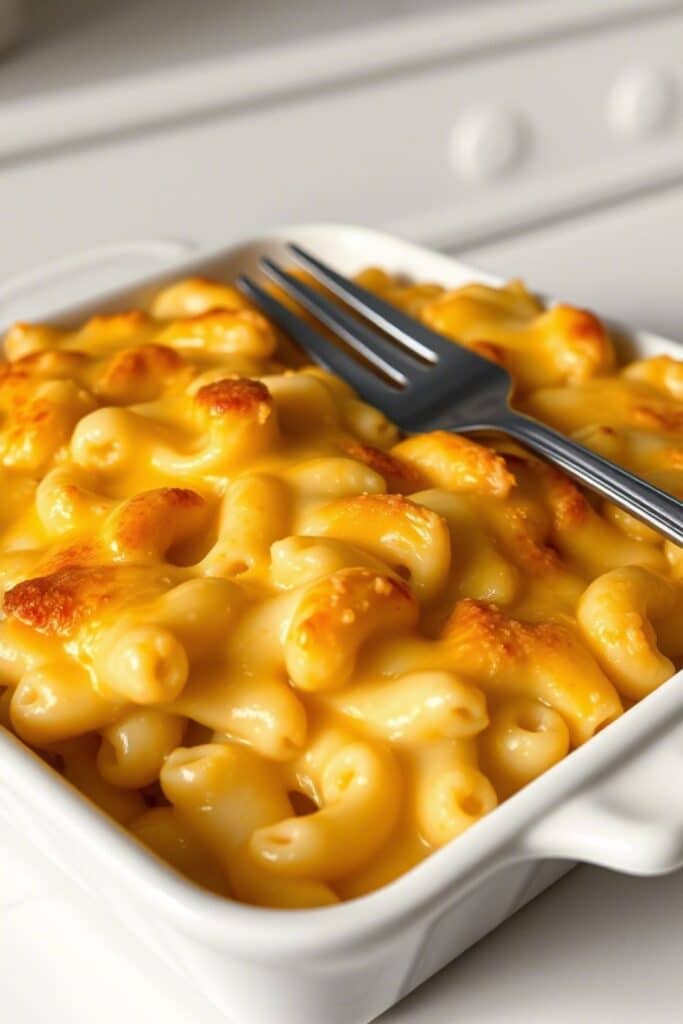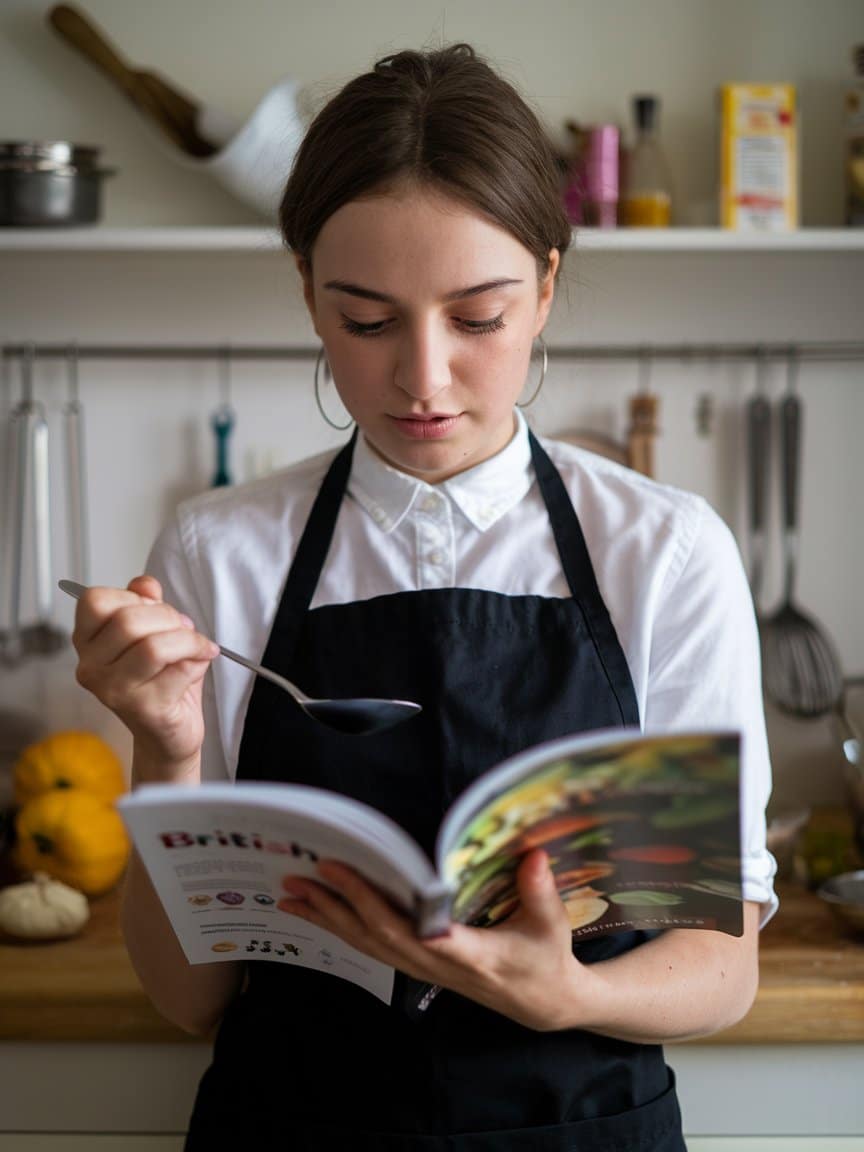I’ll never forget the first time I attempted mac and cheese in culinary school. The instructor, a stern French chef with thirty years experience, watched me dump processed cheese into boiling milk with the kind of horror reserved for war crimes. “Non, non, NON!” he bellowed, snatching the pot away before I could create what he called “plastic soup.”
That humbling moment taught me something crucial: real mac and cheese isn’t about shortcuts or convenience. It’s about understanding the delicate dance between dairy proteins, starch molecules, and fat emulsification that creates that perfect, silky coating around each tender noodle.
What Makes This Recipe Special
Creamy baked mac and cheese represents the pinnacle of comfort food engineering. Unlike stovetop versions that rely on processed cheese products, this recipe builds its foundation on classical French techniques specifically, the béchamel sauce. We’re creating a true cheese sauce from scratch, one that coats every piece of pasta in luxurious, velvety richness.
The magic happens in the oven, where the top develops a golden-brown crust while the interior remains impossibly creamy. This isn’t just melted cheese on noodles; it’s a carefully orchestrated symphony of temperature, timing, and technique.
Ingredients & Substitutions
The Pasta Foundation
- 1 pound elbow macaroni (or cavatappi, shells, or penne)
- 2 tablespoons kosher salt (for pasta water)
The pasta choice matters more than most people realize. Elbow macaroni remains the gold standard because its curved shape creates perfect pockets for cheese sauce. However, cavatappi (corkscrew-shaped) actually holds sauce even better due to its spiral ridges.
The Cheese Sauce Base
- 4 tablespoons unsalted butter
- 4 tablespoons all-purpose flour
- 3 cups whole milk (room temperature)
- 1 cup heavy cream
- 1 teaspoon kosher salt
- 1/2 teaspoon white pepper
- 1/4 teaspoon nutmeg (freshly grated)
Room temperature milk is crucial cold milk added to hot roux creates lumps that are nearly impossible to eliminate. White pepper maintains the sauce’s clean appearance while providing heat that black pepper can’t match.
The Cheese Blend
- 12 ounces sharp cheddar (aged 12+ months), freshly grated
- 4 ounces Gruyère, freshly grated
- 2 ounces Parmesan, freshly grated
- 2 ounces cream cheese, softened
Never, and I mean never, use pre-shredded cheese. The anti-caking agents prevent proper melting and create grainy texture. Sharp cheddar provides the classic tang, while Gruyère adds nutty complexity. Parmesan contributes umami depth, and cream cheese ensures silky smoothness.
The Topping
- 1 cup panko breadcrumbs
- 3 tablespoons butter, melted
- 2 tablespoons fresh parsley, chopped
- 1/4 cup extra sharp cheddar, grated
Quality Substitutions
For lactose-intolerant diners, substitute the milk with lactose-free whole milk the fat content remains crucial for proper sauce development. Nutritional yeast can replace up to 25% of the cheese for a more complex, almost meaty flavor profile.
Gluten-free flour works perfectly as a roux thickener, though you’ll need slightly more (about 5 tablespoons) to achieve the same consistency. For the pasta, choose shapes with good sauce-holding capacity like gluten-free shells or penne.
Step-by-Step Instructions

Pasta Preparation
Bring a large pot of water to a rolling boil. Add salt it should taste like seawater. This isn’t just for flavor; the salt actually helps strengthen the pasta’s structure, preventing mushiness during baking.
Cook the pasta exactly 2 minutes less than package directions. This seems counterintuitive, but the pasta will finish cooking in the oven. Overcooking now creates a mushy final product that even the best cheese sauce can’t save.
Reserve 1 cup of pasta cooking water before draining. This starchy liquid is liquid gold for adjusting sauce consistency later.
The Roux Foundation
In a heavy-bottomed saucepan, melt butter over medium heat. When it stops foaming, add flour and whisk continuously for 2-3 minutes. This cooking time is critical raw flour tastes terrible, but burnt roux is equally disastrous.
The roux should smell nutty and look like wet sand. If it starts browning too quickly, lower the heat immediately.
Building the Béchamel
Slowly add room-temperature milk, whisking constantly to prevent lumps. Add it in three additions, whisking vigorously between each pour. The sauce will seem thin at first don’t panic.
Increase heat to medium-high and cook, stirring constantly, until the sauce coats the back of a spoon. This takes about 8-10 minutes. The sauce is ready when you can draw a line through it with your finger and it doesn’t immediately fill back in.
Cheese Integration
Remove the pan from heat this is crucial. Hot surfaces cause cheese proteins to seize and separate. Add cream cheese first, whisking until completely smooth. Then add grated cheeses one handful at a time, whisking until each addition melts completely.
Season with salt, white pepper, and nutmeg. Taste and adjust the sauce should be slightly overseasoned because the pasta will dilute the flavors.
Assembly
Combine pasta and cheese sauce in a large bowl. If the mixture seems too thick, add reserved pasta water one tablespoon at a time. The consistency should coat the pasta generously but not be soupy.
Transfer to a buttered 9×13 inch baking dish. Don’t pack it down you want air pockets for even heating.
The Perfect Topping
Mix panko breadcrumbs with melted butter and parsley. This creates a golden, crunchy contrast to the creamy interior. Sprinkle evenly over the surface, then top with additional grated cheese.
Baking to Perfection
Preheat oven to 375°F. Bake for 25-30 minutes, until the top is golden brown and the edges are bubbling. If the top browns too quickly, tent with foil for the remaining time.
Let rest for 10 minutes before serving. This allows the sauce to set slightly and prevents a molten lava situation.
Cooking Techniques & Science

The Science of Smooth Sauce
Creating a lump-free cheese sauce relies on proper emulsification. The roux (flour and butter) creates a stable base that prevents fat separation. When cheese is added to this base at the correct temperature, the proteins form a smooth network instead of clumping together.
Temperature control is everything. Too hot, and proteins seize into rubbery clumps. Too cool, and the sauce won’t thicken properly. The sweet spot is around 160-170°F hot enough to melt cheese completely but not so hot that proteins denature.
Maillard Reaction Magic
The golden-brown top develops through the Maillard reaction the same process that creates the crust on bread and the sear on steak. Proteins and sugars in the cheese interact with heat, creating hundreds of flavor compounds that add complexity beyond simple cheese flavor.
Tool Selection Impact
A heavy-bottomed saucepan distributes heat evenly, preventing hot spots that cause scorching. A whisk with thin wires incorporates air and prevents lumps better than thick-wired versions.
The baking dish material affects cooking time. Glass or ceramic dishes heat more gently than metal, requiring slightly longer baking times but providing more even results.
Serving & Pairing Suggestions
Presentation Excellence
Serve immediately after the resting period, when the sauce is still creamy but not molten. Use a large spoon to ensure each serving includes both creamy interior and crispy top.
For elegant presentation, try individual ramekins. Reduce baking time to 18-20 minutes and garnish with fresh chives or crispy bacon crumbles.
Complementary Pairings
The richness of mac and cheese demands acidic accompaniments. A simple arugula salad with lemon vinaigrette cuts through the heaviness beautifully. Pickled vegetables especially dill pickles or pickled jalapeños provide necessary acidity and textural contrast.
For beverages, choose something with enough acidity to cleanse the palate. A crisp white wine like Sauvignon Blanc or even a hoppy IPA provides the perfect counterpoint to all that creamy richness.
Side Dish Harmony
Keep sides simple and fresh. Roasted Brussels sprouts with bacon, steamed broccoli with lemon, or a crisp coleslaw all provide textural and flavor contrast without competing for attention.
Troubleshooting Common Issues
Grainy Texture Solutions
Grainy mac and cheese usually results from overheating the cheese or using pre-shredded varieties. If this happens, remove from heat immediately and whisk in a tablespoon of cold cream. The cold dairy can sometimes restore smoothness.
Preventing Dryness
Dry mac and cheese often means the sauce was too thick initially or the oven temperature was too high. Always err on the side of slightly loose sauce it will tighten as it bakes.
Separation Recovery
If the sauce separates during cooking, remove from heat and whisk in cold milk one tablespoon at a time. Sometimes starting over is necessary, but this technique works about 70% of the time.
Creative Variations

Protein Additions
Lobster mac and cheese elevates this comfort food to restaurant status. Fold in 1 pound of cooked lobster meat during the final assembly. The sweet shellfish pairs beautifully with the sharp cheese blend.
Pulled pork or braised short rib creates a heartier version perfect for cold weather. Add the meat after combining pasta and sauce, before baking.
Spice Modifications
For heat lovers, add 1 teaspoon of cayenne pepper to the cheese sauce or fold in diced jalapeños. Smoked paprika provides warmth without excessive heat.
Seasonal Adaptations
Spring version: fold in blanched asparagus and fresh peas. Summer: add roasted tomatoes and fresh basil. Fall: incorporate roasted butternut squash and sage.
The beauty of perfect mac and cheese lies in its versatility. Once you master the basic technique, endless variations become possible. The key is understanding that great mac and cheese isn’t about following a recipe blindly it’s about understanding the science behind why each step matters.
This isn’t just comfort food; it’s comfort food executed with technical precision. Every element, from the pasta shape to the cheese selection to the final baking temperature, contributes to the overall success. When done correctly, each bite delivers that perfect balance of creamy, cheesy richness with just enough textural contrast to keep things interesting.
The difference between good mac and cheese and great mac and cheese often comes down to patience and attention to detail. Take the time to grate fresh cheese, maintain proper temperatures, and let the dish rest before serving. These small steps separate amateur attempts from professional results.
Remember: shortcuts in mac and cheese rarely work. The techniques I’ve outlined here might seem involved, but they’re the foundation of restaurant-quality results. Master these basics, and you’ll never want boxed mac and cheese again.
Frequently Asked Questions?
Q: Can I make this mac and cheese ahead of time?
A: Absolutely! Assemble the dish completely but don’t add the breadcrumb topping. Cover tightly and refrigerate for up to 2 days. When ready to bake, let it come to room temperature for 30 minutes, add the topping, and bake as directed, adding 5-10 extra minutes if needed.
Q: Why does my cheese sauce turn grainy or separate?
A: This usually happens when the cheese gets too hot or when you add it too quickly. Always remove the sauce from heat before adding cheese, and incorporate it gradually. Using freshly grated cheese instead of pre-shredded also prevents this issue since pre-shredded contains anti-caking agents.
Q: Can I freeze baked mac and cheese?
A: Yes, but the texture will change slightly. Freeze in individual portions for up to 3 months. Thaw overnight in the refrigerator, then reheat at 350°F until warmed through. Add a splash of milk if it seems dry.
Q: What’s the best way to reheat leftover mac and cheese?
A: Reheat in a 350°F oven with a splash of milk or cream to restore creaminess. Cover with foil to prevent the top from over-browning. Individual portions reheat well in the microwave at 50% power, stirring every 30 seconds.
Q: Can I make this gluten-free?
A: Yes! Use gluten-free pasta and substitute the all-purpose flour with a 1:1 gluten-free flour blend. You might need slightly more flour (about 5 tablespoons instead of 4) to achieve the same thickening power. The rest of the recipe remains unchanged.

Veronica is a passionate food enthusiast with over three years of experience in exploring and writing about diverse cuisines. Her expertise lies in reviewing restaurants, sharing creative recipes, and discovering the latest food trends. As the voice behind FoodieRecap.com, Anju brings fresh perspectives and culinary insights to her audience.
